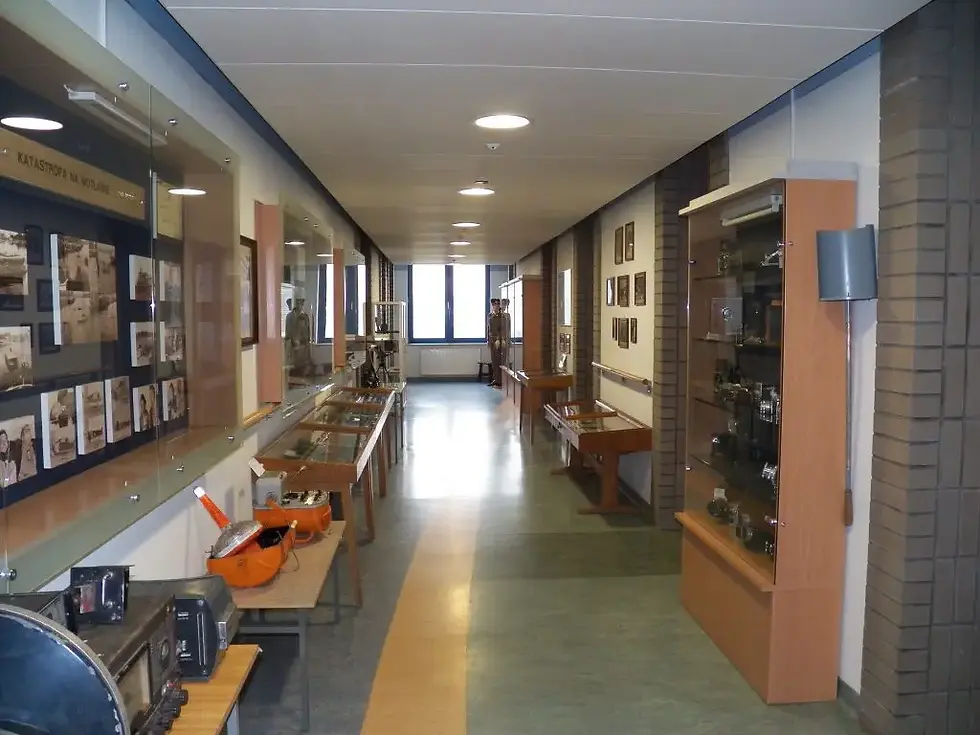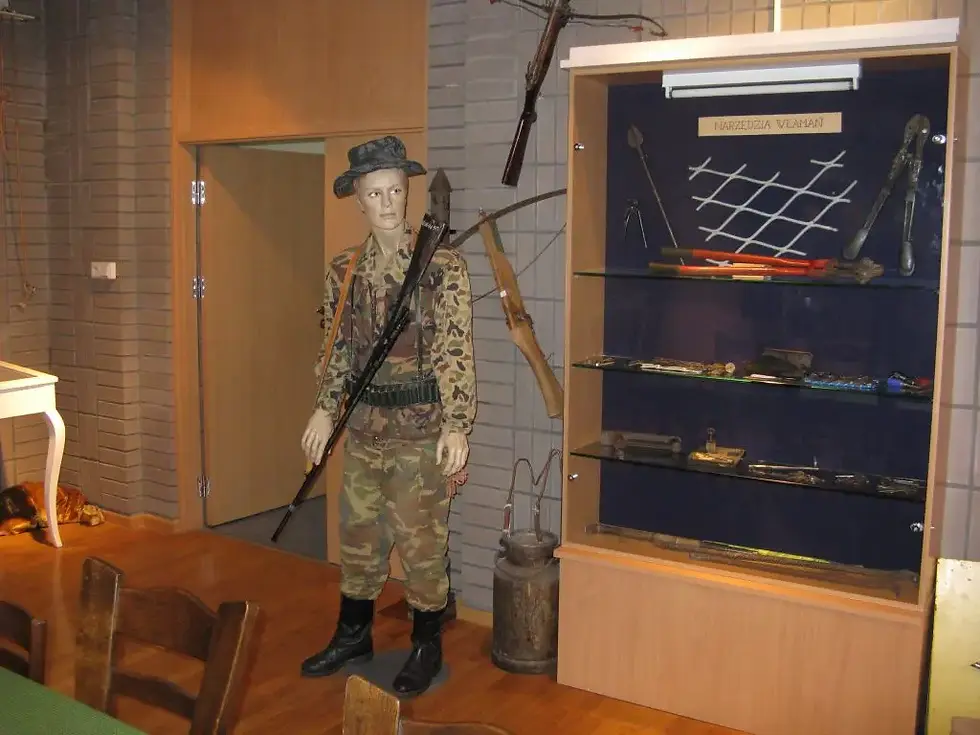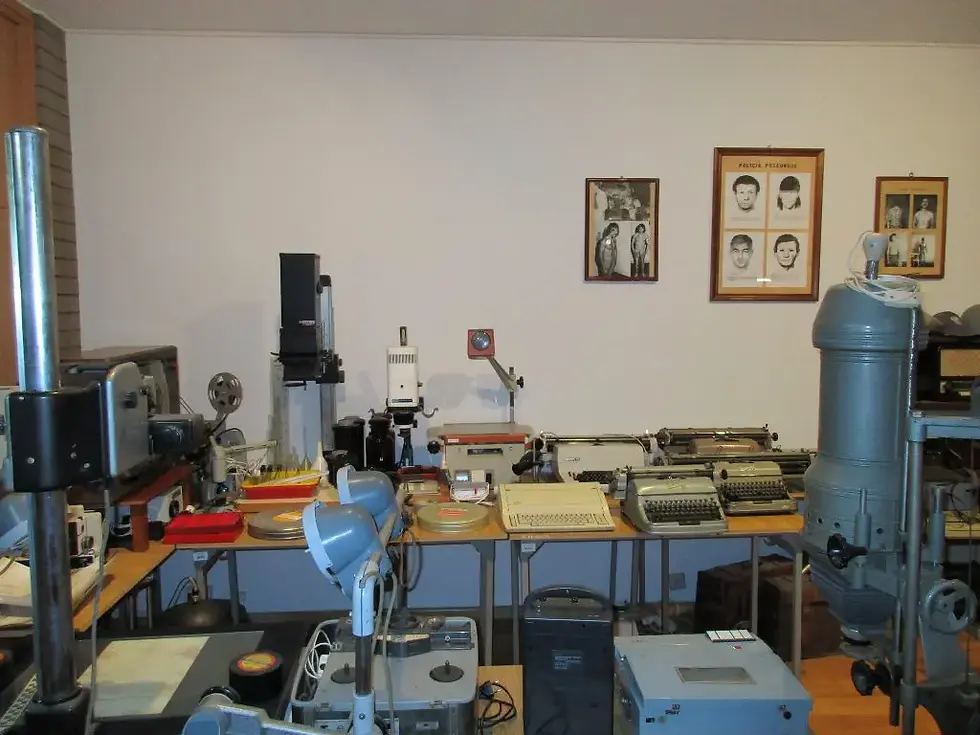Museum of Forensic Science: A Guide to an Unusual Museum
- Damian Brzeski

- Sep 6
- 8 min read
Could Gdańsk hold a hidden attraction that evokes more emotion than the sight of Neptune or amber stalls? Within the inconspicuous building of the University of Gdańsk lies a place where science meets the darkness of human nature.
A serial killer's gallows, a home-made weapon, and authentic evidence of crimes are just some of the exhibits that transform a visit into an unforgettable journey on the border between fascination and horror. This museum is not just an attraction—it's an experience that will linger in your memory forever.

An invitation to the extraordinary world of crime
Forget historic dungeons and dark cellars. The Museum of Forensic Science is housed not in a medieval torture chamber, but within the modern, almost sterile walls of the Faculty of Law and Administration of the University of Gdańsk in Oliwa .
This apparent dissonance is key to understanding this place. The absence of a Gothic setting strips the crime of its aura of romance and mystery, forcing you to confront its scientific, cold, and terrifyingly real dimensions.
This place is unique among Polish attractions. Numerous sources unanimously emphasize its absolute uniqueness – it is the only facility of its kind in Poland , and no other Polish university can boast such unique collections.
This isn't just another history exhibition; it's an entrance into a true archive of evidence, where each object tells a story that will make your hair stand on end. From the very beginning, your imagination will be captured by the promise of witnessing an authentic
the gallows where a serial killer was executed, human organs preserved in formalin or a real, modern mummy found in the land of Gdańsk.
The museum is not an ordinary tourist attraction – it is a portal to a world where science clashes with the darkest aspects of human nature.
Museum History: A Collection Born from a Passion for Lawlessness
The history of this extraordinary collection is inextricably linked to the figure of its founder, Dr. Jerzy Wnorowski .
Described as a man of "extraordinary passion" for whom the museum was "his life, his career, and his money," he began his collection with his personal items. This personal commitment gave the collection a soul and authenticity that you can still feel today.
Initially, in 1983, the collection found its home in a place with a unique atmosphere – the Prison Tower and Torture Chamber Complex at Targ Węglowy in Gdańsk . This location allowed for a fascinating fusion of history and the present.
Visitors could first learn about the history of medieval justice, and then immerse themselves in the world of contemporary forensics. Interestingly, the idea of documenting crime in Gdańsk has deeper roots.
Already in the Free City of Danzig, in the spring of 1925, a forensic museum was opened in the building of the Police Presidium , which also presented murder weapons, photos from crime scenes, and even preserved body parts of the victims.
A breakthrough came in 2001, when the decision was made to house the Amber Museum in the Torture Chamber. The Forensic Science Laboratory and its priceless collections were moved to the newly constructed building of the Faculty of Law and Administration of the University of Gdańsk.
At this point, its main purpose changed – the collections began to serve primarily educational purposes, educating future lawyers.
This evolution from a public exhibition in a historic location to an academic tool in a modern building is crucial to understanding the museum's identity.
Finally, on June 28, 2012, the museum was formally established as a separate entity, and in early 2013 its doors reopened to the general public, creating a unique hybrid of a scientific and public institution.

What can you see inside the Forensic Science Museum?
Warning: The following descriptions refer to exhibits of a graphic nature. Please remember that the museum is intended for adults and older youth, and caution is advised for those with sensitive skin.
The Scorpion Case: A Close-Up of the Crime
The centerpiece and most shocking part of the collection is the exhibition dedicated to Paweł Tuchlin , the serial killer known as "Scorpion." It is here that the abstract concept of crime takes on a tangible, terrifying form. In the display case, you will see an authentic
The hammer he used to hit his victims was found in the trunk of his Warsaw car. Nearby are his footprints and shoes, which helped identify him.
However, it is another object that dominates this part of the exhibition – the original gallows , on which the death sentence was carried out in Tuchlin on May 25, 1987. This is not a replica. It is the authentic instrument that ended the life of one of the most dangerous criminals in Polish history. Its historical significance is enormous – it was
the last execution carried out in Gdańsk and the penultimate in all of Poland, which makes the gallows a grim monument to the bygone era of the death penalty.
Weapons of crime and fraud
The museum boasts an impressive collection of weapons, representing a cross-section of the tools of violence and crime. Here you'll find firearms—from antiques and military to sporting and gas weapons—as well as bladed weapons. Many of these exhibits come from ballistics expertise conducted during actual criminal proceedings.
Particularly fascinating is the section devoted to homespun weapons —primitive yet deadly devices fashioned from everyday objects like bicycle frames and sewing machines. They testify to the desperation and dark ingenuity of the criminal underworld.
The collection is complemented by burglary tools, counterfeit banknotes and coins (both Polish and foreign) and items confiscated from inmates in prisons and detention centers.
The Dark Secrets of Forensic Medicine
This is a section for people with the strongest nerves, where science meets death in its most literal form.
Human organs rest in glass jars, immersed in formalin – some with visible gunshot wounds, others documenting the effects of various injuries. The exhibition also includes deformed fetuses whose defects led to the death of their mothers – exhibits of immense scientific value, serving both research and education.
A unique object is a natural human mummy from the modern era. It was accidentally discovered during construction work in Gdańsk in the 1980s and represents a unique combination of forensic science and urban archaeology.
The forensic collection is complemented by extensive photographic documentation from crime scenes, accidents, and suicides. Visitors described some of these images as so graphic that they were unable to look at them a second time, demonstrating the exhibition's uncompromising realism.
Memory of the Gdańsk tragedies
In the corridor leading to the main exhibition hall, display cases commemorate great tragedies from Gdańsk's recent history. Photographs document the consequences.
the ferry disaster on the Motława River in 1975 , the bus accident in Kokoszki in 1994, and the gas explosion in a high-rise building in the Strzyża district in 1995. These photos place the museum's subject matter in a local context, recalling events that shocked the community and became permanently etched in its memory.

Guided tours – the key to understanding
A visit to the Forensic Science Museum is an experience unavailable to the casual passerby. Tours are available only in organized groups by appointment, with the guide playing a key role.
Curator Janusz Czeczko is considered by many visitors to be the greatest asset of this place.
Described as a "true expert" who has "completely devoted himself to forensics," Mr. Janusz turns the tour into a gripping story.
This isn't a dry recitation of facts, but a narrative spectacle in which exhibits become props in stories of crime, investigation, and justice. Thanks to his "engaging and passionate storytelling," you'll receive "a wealth of valuable, yet somewhat shocking, information."
It is this human perspective, full of knowledge and commitment, that makes the museum, as one student put it, a “space of surprises” that leaves an unforgettable “wow!” effect.
The mandatory guided tour format also ensures that graphic content is presented in an appropriate, scientific context, preventing the visit from being reduced to cheap sensationalism.
How to plan your visit and practical information about this extraordinary museum
VERY IMPORTANT: According to the information on the official website, the museum is temporarily closed . Before you plan any visit,
It is absolutely necessary to contact the facility by phone or email to confirm its current status, availability and visiting rules.
Restrictive access rules—appointment required, small groups, limited opening hours, and now a temporary closure—paradoxically enhance the museum's appeal. A visit ceases to be a standard tourist activity and becomes an entrance into an exclusive, hidden world, intensifying the impression of experiencing something exceptional.
It is also worth mentioning that although the Gdańsk facility is unique in the country due to its university character and forensic medicine collections, there is also another Criminalistics Museum in Poland, located at the Police School in Słupsk.
Category | Information |
Status | Temporarily Closed (Must be verified by phone/email) |
Address | ul. Bażyńskiego 6, 80-309 Gdańsk (Faculty of Law and Administration, University of Gdańsk) |
Contact | Tel.: 58 523 29 01; E-mail: sklep@prawo.ug.edu.pl |
Website | |
Entrance fee | Free |
Opening hours (when open) | Monday - Friday, 8:00 a.m. - 2:00 p.m. |
Reservation | Required, after prior arrangement of the date |
Groups | Up to 15-25 people |
For whom? | Adults and older youth (secondary schools) |

A visit to the Faculty of Law and Administration that you will never forget
A visit to the Forensic Museum in Gdańsk is a borderline experience. It's much more than just satisfying your macabre curiosity.
This is a profound, educational journey that offers a raw, unfiltered look at the science of deduction, the history of crime, and the darkest recesses of the human psyche. The authenticity of the collection, combined with the guide's masterful narration, creates an experience that is both disturbing and captivating.
When you leave the sterile corridors of the university, you will no longer think only of amber and Neptune. Images that will remain in your minds will force you to reflect on the fragility of life, the nature of evil, and the tireless pursuit of truth.
For anyone with nerves of steel and an insatiable curiosity, the Forensic Museum is an absolute must-see in Gdańsk – a place that will remain in your memory long after memories of more conventional attractions have faded.
Frequently asked questions about the Forensic Science Museum in Gdańsk
What is the Forensic Science Museum in Gdańsk?
This unique facility, located at the Faculty of Law and Administration of the University of Gdańsk, presents authentic crime evidence, forensic medicine exhibits, and archival materials related to the history of crime.
Where is the museum?
The museum is located in the building of the Faculty of Law and Administration of the University of Gdańsk at ul. Bażyńskiego 6, 80-309 Gdańsk (Oliwa).
What exhibits can you see?
The collection includes, among others, the original gallows on which the last execution in Gdańsk was carried out, the hammer of the serial killer "Scorpion", firearms and homespun weapons, counterfeit banknotes, human organs in formalin, and a natural mummy discovered in Gdańsk.
Is the museum suitable for children?
No. Due to the graphic nature of many of the exhibits, the museum is intended for adults and older youth (secondary school age).
Is the museum currently open?
According to official information, the museum is temporarily closed . Before planning a visit, please contact us by phone (58 523 29 01) or email ( muzeum@prawo.ug.edu.pl ) to confirm availability.
Is there an admission fee to the museum?
No, admission to the Forensic Museum is free.
What are the rules for visiting?
Tours take place only in small groups (15–25 people).
Advance booking is required.
The tour is always guided.
Who gives tours of the Forensic Science Museum in Gdańsk?
Visitors are guided by curator Janusz Czeczko, known for his passion and knowledge, thanks to which the visit takes the form of a fascinating story, not just a dry presentation of exhibits.
Are there any other forensic museums in Poland?
Yes. In addition to the Gdańsk museum, the Forensic Science Museum at the Police School in Słupsk also displays its collections.
































































Comments